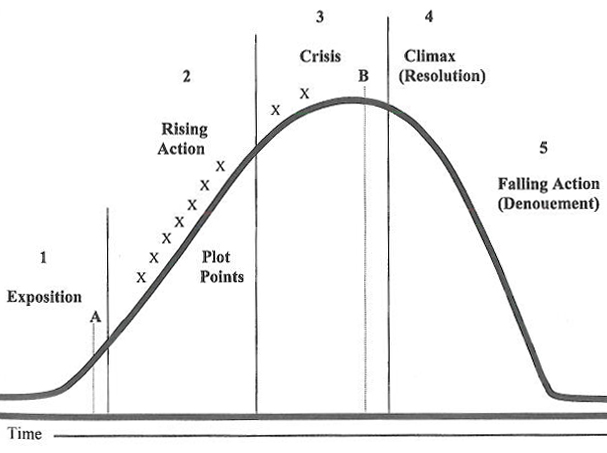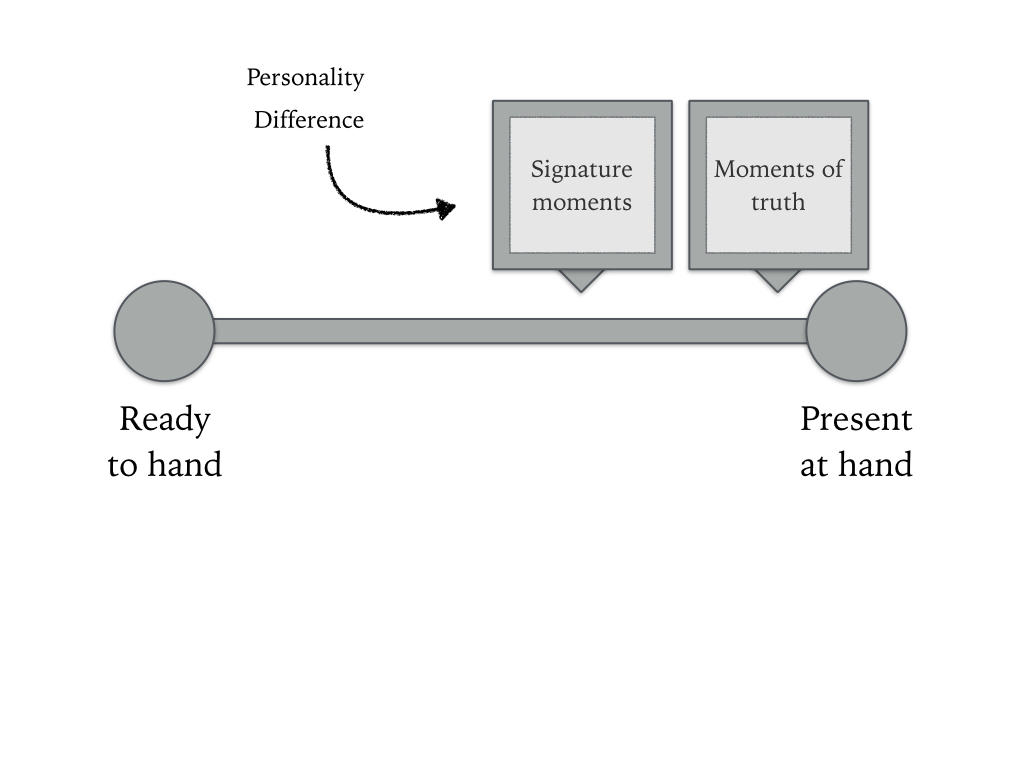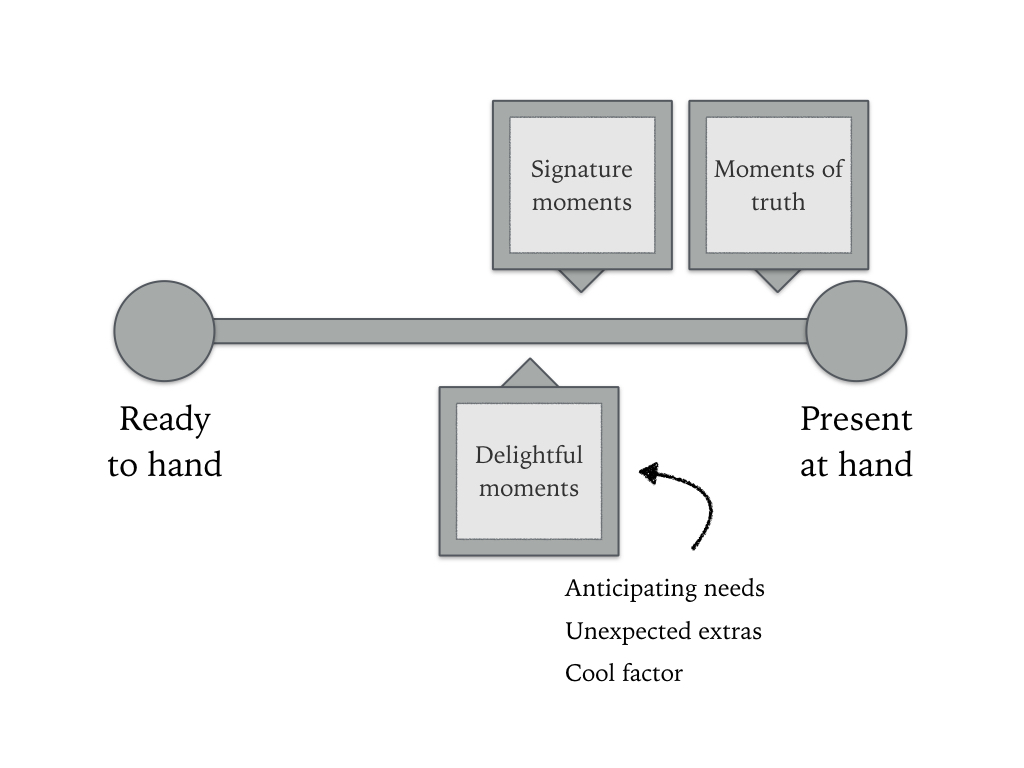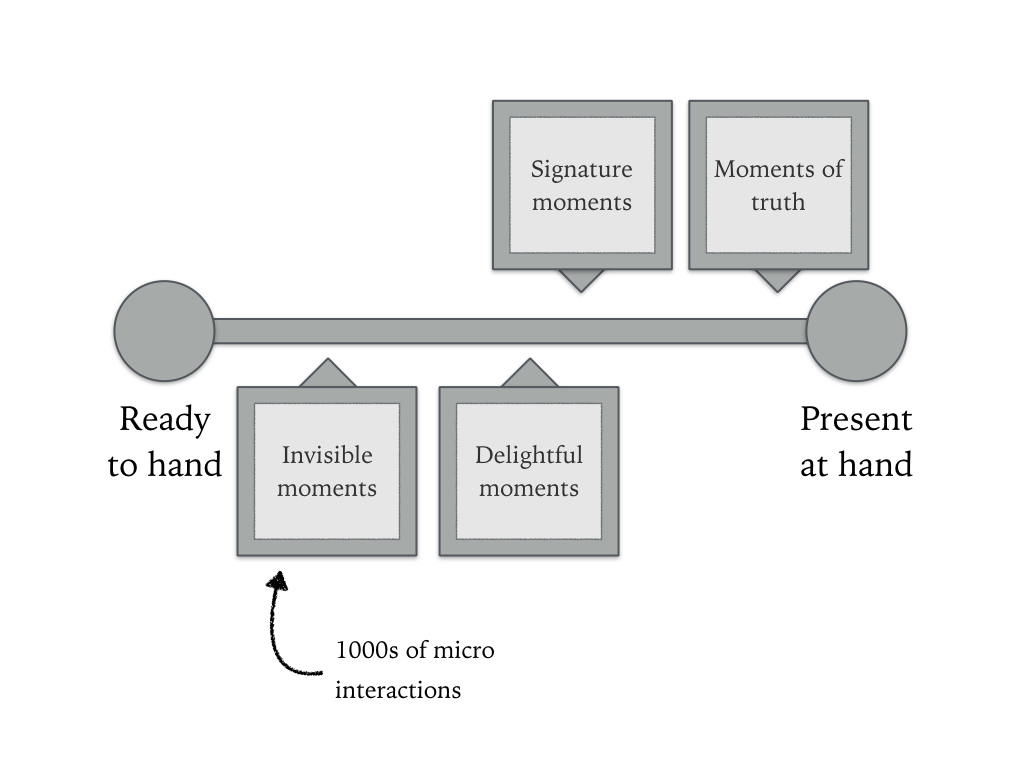User Journeys involve a string of linked moments that aim to provide a plausible (and hopefully a research-based) account of how someone might move towards greater levels of engagement with a brand, service or product. Each journey will usually involve lots of little events, culminating in one big moment where the user does that thing we hope they’ll do; such as buy, upgrade, sign up, share, follow, upload, download… and so on.
Moment types
But it’s worth thinking of more than just micro and macro moments. Moments have many differing qualities, and an interesting journey might encourage more than one type. It may even map to a narrative arc.

For me, this is where Heidegger comes in!
Martin Heidegger, an early 20th Century German Philosopher, describes two ways that we experience objects within the world. Objects in the world can either be:
1) ready-to-hand, or
2) present-at-hand.

‘Ready-to-hand’ is an unconscious experience. When I encounter something in this way, I am in a state of ‘flow’ and I am thinking fast. I perceive the ‘chair’ as being interconnected with the objects around it.
‘Present-at-hand’ is a conscious experience. When I encounter something in this way, I am out of the ‘flow’ and I am thinking slowly. I perceive the ‘chair’ as a separate entity.
In our daily life, we tend to experience a mixture of these two states. I am likely to encounter ‘chairs’ in a way that is neither entirely ‘ready-to-hand’ nor entirely ‘present-at-hand’. I might for example, give it a vague thought, such as, “oh, nice chair!” and then get on with the project of sitting down on it. So what we’re looking at here is a spectrum between two extremes, along which it is possible to have a wide variety of different types of experience.
We can use this spectrum to model the different types of moments considered within digital user journeys. Here are four moment-types I have experienced:
Moments of truth

These are moments where users cross a threshold of understanding and take a corresponding action. The experience is meaningful and the resulting action is deliberate and meditated. When we put these types of moments into user journeys, they are often used to describe the most important events from a business perspective. They might, for example, be moments where the customer is acquired, or retained.
Moments of truth happen when users come face to face with a product, service or brand. They usually won’t want this to happen too often, preferring to get on with their lives, and using the product or service in a ‘ready-to-hand’ way. As such, it may be wise to include only a few such moments, but to design them with extreme care (given their critical importance from a business perspective).
Signature moments

These are moments where a brand speaks to users. They become aware of its personality. Signature moments show users something unique and are in need of regular refreshing. What can seem special today, doesn’t feel that way when everybody is doing it, or when the competition manages to cook up something better.
The key thing is that they are ‘ready-to-hand’ insofar as they call themselves out to us. They make us remember that something is different here. Something special is going on.
Delightful moments

Whereas ‘invisible moments’ meet the user’s immediate needs, ‘delightful moments’ exceed their needs and add in a little extra.
Delight happens when the user feels that thanks to the speedy and thoughtful actions of the product or service they’re dealing with, they’re able to enter or return to a realm of ready-to-hand (a comfortable place). They remember these experiences with gratitude and are happy to tell others about them.
Invisible moments

These are moments that happen without customers noticing them. Things just work seamlessly and no barriers get in the way. There is no reason to think.
Invisible moments happen when users are helped along the right path or prevented from making wrong turns. They are the most ready-to-hand of the moments described here.
Triggering these ‘moment types’
Ready-to-hand moments work really well when triggered by a brand, product or service. They make users feel cared for and respected. It feels great to be in the flow. Users will thank you for at least some of the hard work you put in to helping them to get that experience.
Present-at-hand moments work best when triggered by the user. Pushing users into these moments can feel pestering, desperate or annoying. For example, you have to earn your right to present the ‘BUY NOW’ call to action, ideally with a series of ready-to-hand experiences that accumulate in an engaging way. You have to allow your customers to ‘try before they buy’, or to come to understand the offering vicariously through a video or online demo. Users want to learn by playing, not by reading. As such, the ready-to-hand should nearly always come before the present-at-hand moments in customer journeys.
Balancing these ‘moment types’
There is a trend towards crafting entirely ready-to-hand user experiences. We seem to hope that more and more of the complexities of life will be managed for us, with smart algorithms reading our behaviour and anticipating our next move. Designers focus on joined-up experiences that provide a product and an ecosystem to go with it. We become so addicted to flow, that we forget the value of thinking. We are even willing and eager to buy goods in a ready-to-hand manner. For example, eBay’s in-the-moment bidding, or iTunes micro-payments help us to part with cash in a more or less frictionless way.
It is worth remembering though, that the practice of UX design is not just about finding and removing the barriers that impede user action. Users who interact in mindful ways are more likely to find meaning and fulfilment in their experience. This is still, and will always be, where the real action is.

